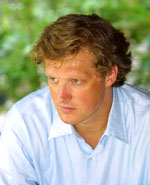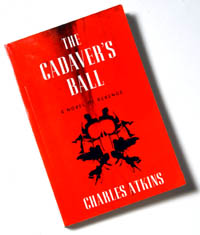Alternative Atlanta by Marshall Boswell 96PhD
Marshall Boswell's debut novel, Alternative Atlanta, takes place during the same year he received his Ph.D. in English from Emory University. During his tenure at Emory, however, Boswell 96PhD daydreamed of writing music reviews for Creative Loafing.
 “I started school at Emory right around the time grunge rock was breaking into the scene,” he says. “Most of the reviews I saw were more concerned with Nirvana's record sales. I wanted to show the genealogy.” “I started school at Emory right around the time grunge rock was breaking into the scene,” he says. “Most of the reviews I saw were more concerned with Nirvana's record sales. I wanted to show the genealogy.”
An ardent music fan and guitarist for his own band Enormous Richard in the late ’80s, Boswell had been tracking the music scene for years and was ahead of the curve.
After he received his doctorate from Emory, he went on to become the T. K. Young Professor of English at Rhodes College in Memphis. But he continued to mull over his experience and people he knew from Atlanta.
“The more I worked on the book,” he says, “the less Atlanta seemed like a recent memory, but instead marked the end of an era.”
His novel captures the close of the 1990s—“the end of Clinton innocence and grunge rock.”
The novel features a thirty-year-old graduate-school dropout named Gerald Brinkman, who feels “out of his league [living] in glorious Virginia Highlands.”
Gerald writes music reviews for the fictional “free weekly newspaper” the titular Alternative Atlanta .
Much of the novel Alternative Atlanta, which reads almost like a road map of Atlanta, reflects Boswells own life: “Gerald now tries to picture his father stepping off the plane and into the United Nations sprawl of the Hartsfield International Airport.” Boswell admits to many similarities between himself and his fictional character, but says “Gerald is a little grittier—more rock and roll,” Boswell laughs. “I have a house, two kids, and I cut the grass.”
Readers first entered the fictional world of Alternative Atlanta in Boswell's short story “In Between Things,” included in his acclaimed 2003 collection, Trouble with Girls. In addition to his fiction, Boswell has published two works of literary scholarship: John Updike's Rabbit Tetralogy: Mastered Irony in Motion (University of Missouri Press) and Understanding David Foster Wallace (University of South Carolina Press).
Although he enjoys both fiction and scholarly writing, Boswell asserts that they are distinctly different pursuits.
“Writing fiction is like taking a journey without the map. Academic writing is like digging a ditch and laying the pipe.”
The Cadaver's Ball: A Novel of Revenge, by Charles Atkins 90M
While a student at the Emory School of Medicine, Charles Atkins 90M won an essay contest for Atlanta Medicine and has since published a myriad of articles, essays, and novels.
Atkins admits he has always been an obsessive journal writer. Today, when he isn't working as the regional medical director for the State of Connecticut, maintaining a faculty appointment at the Yale School of Medicine, or writing, Atkins returns to journaling.  “It's kind of like a pianist playing the scales,” he says. “It loosens things up.” “It's kind of like a pianist playing the scales,” he says. “It loosens things up.”
His newly released third novel, The Cadaver's Ball, is a psychological thriller set in Manhattan, although he confesses he “nabbed” the idea for the title from the actual dance held at Emory.
Part of the novel is set in a medical school and those familiar with the Emory medical school will see the similarities to his alma mater. In the prologue to The Cadaver's Ball, the villain wears the same costume Atkins wore to Emory's ball:
“I know who you are,” she said. “You're Death taking a holiday.”
“Yes.” He removed his mask, a skull to which he'd glued a pair of Mickey Mouse ears.
“I spent a year at Emory cutting up dead bodies,” Atkins says and describes a dream he had during medical school. “I suddenly started hearing a drum beat. All the cadavers jumped up and joined in a huge dance number.”
In The Cadaver's Ball, Atkins' character Peter Grainger see a similar vision while up late preparing a dissection for class in the morning.
Atkins says he uses fiction to explore what he sees clinically as a psychiatrist everyday. While finishing his residency at Yale, Atkins wrote his first novel, The Portrait, in which the protagonist faces a serious mental illness. His second novel, Risk Factor, was inspired by his work with adolescents.
“One of my goals in writing novels,” he says, “is getting complex clinical theory into understandable and readable stories.”
With The Cadaver's Ball Atkins tackles the “effects of trauma, how it changes people and how they transcend it.”
At the same time, he stays true to his thriller genre. Atkins has noticed, however, that “the direction of my novels is getting a bit darker as I slip away from the mystery genre and move more squarely into suspense and thrillers.”
In addition to his novels, Atkins publishes short stories, articles and essays in newspapers, professional journals, and magazines. He has been a consultant for the Reader's Digest Medical Breakthrough Series and a contributor to the American Medical Association's American Medical News as well as in newspapers and magazines, including the New York Times and the Hartford Courant. Atkins still manages to find time for a bit of yoga before work, which, he jokes, “keeps me from killing people in real life.”
|